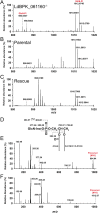The Leishmania donovani Ortholog of the Glycosylphosphatidylinositol Anchor Biosynthesis Cofactor PBN1 Is Essential for Host Infection
- PMID: 35420475
- PMCID: PMC9239262
- DOI: 10.1128/mbio.00433-22
The Leishmania donovani Ortholog of the Glycosylphosphatidylinositol Anchor Biosynthesis Cofactor PBN1 Is Essential for Host Infection
Abstract
Visceral leishmaniasis is a deadly infectious disease caused by Leishmania donovani, a kinetoplastid parasite for which no licensed vaccine is available. To identify potential vaccine candidates, we systematically identified genes encoding putative cell surface and secreted proteins essential for parasite viability and host infection. We identified a protein encoded by LdBPK_061160 which, when ablated, resulted in a remarkable increase in parasite adhesion to tissue culture flasks. Here, we show that this phenotype is caused by the loss of glycosylphosphatidylinositol (GPI)-anchored surface molecules and that LdBPK_061160 encodes a noncatalytic component of the L. donovani GPI-mannosyltransferase I (GPI-MT I) complex. GPI-anchored surface molecules were rescued in the LdBPK_061160 mutant by the ectopic expression of both human genes PIG-X and PIG-M, but neither gene could complement the phenotype alone. From further sequence comparisons, we conclude that LdBPK_061160 is the functional orthologue of yeast PBN1 and mammalian PIG-X, which encode the noncatalytic subunits of their respective GPI-MT I complexes, and we assign LdBPK_061160 as LdPBN1. The LdPBN1 mutants could not establish a visceral infection in mice, a phenotype that was rescued by constitutive expression of LdPBN1. Although mice infected with the null mutant did not develop an infection, exposure to these parasites provided significant protection against subsequent infection with a virulent strain. In summary, we have identified the orthologue of the PBN1/PIG-X noncatalytic subunit of GPI-MT I in trypanosomatids, shown that it is essential for infection in a murine model of visceral leishmaniasis, and demonstrated that the LdPBN1 mutant shows promise for the development of an attenuated live vaccine. IMPORTANCE Visceral leishmaniasis is a deadly infectious disease caused by the parasites Leishmania donovani and Leishmania infantum. It remains a major global health problem, and there is no licensed highly effective vaccine. Molecules that are displayed on the surface of parasites are involved in host-parasite interactions and have important roles in immune evasion, making vaccine development difficult. One major way in which parasite surface molecules are tethered to the surface is via glycophosphatidylinositol (GPI) anchors; however, the enzymes required for all the biosynthetic steps in these parasites are not known. Here, we identified the enzyme required for an essential step in the GPI anchor-biosynthetic pathway in L. donovani, and we show that while parasites lacking this gene are viable in vitro, they are unable to establish infections in mice, a property we show can be exploited to develop a live genetically attenuated parasite vaccine.
Keywords: bioluminescence; enzyme; glycophosphatidylinositol biosynthesis; leishmaniasis; mass spectrometry; parasitology.
Conflict of interest statement
The authors declare no conflict of interest.
Figures





References
-
- WHO. 2021. Leishmaniasis fact sheet. WHO fact sheet.
-
- WHO. 2016. Leishmaniasis in high-burden countries: an epidemiological update based on data reported in 2014. Wkly Epidemiol Rec 91:287–296. - PubMed
Publication types
MeSH terms
Substances
Grants and funding
LinkOut - more resources
Full Text Sources
Medical
